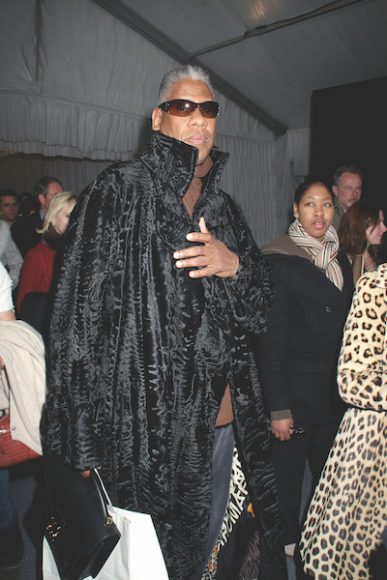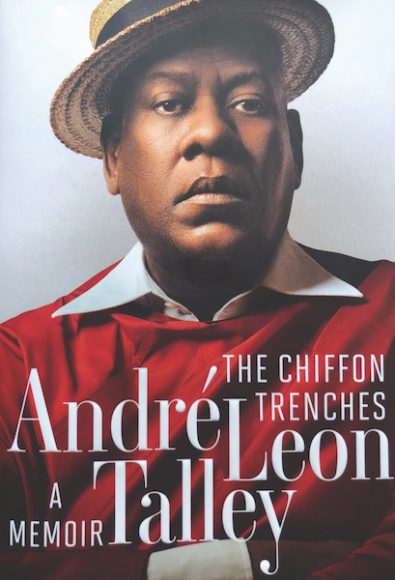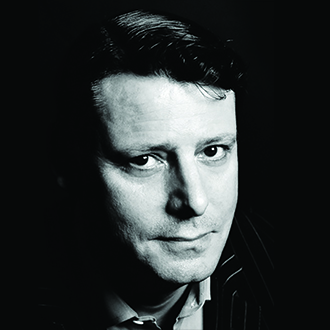There’s a wonderful scene in André Leon Talley’s unputdownable new “The Chiffon Trenches: A Memoir” (Ballantine Books, 304 pages) when Talley, having just been summarily axed from conducting his traditional red-carpet interviews at the 2018 Met Costume Institute Gala, has a lightbulb moment. All but canceled by Condé Nast and abandoned by Anna Wintour, Vogue’s editrix in chief and Condé Nast artistic director, but nevertheless seated at a not-exactly-B-list table with John Galliano, Vera Wang and Rhianna, Talley finds a fake smile stretching across his lips, and his hands clenching in silent disgust. Suddenly, though, he feels resolute. Before the evening has scarcely begun, he stands up, and with a twirl of his Tom Ford black double-face faille cape, sweeps out of The Met, down to his waiting car and home to the sanctuary of his house in White Plains.
A great exit, as all dramatic persons know, is as effective as a great entrance and Talley has seen a few of each in his time. He is, of course, the former creative director of Vogue, one of the most influential fashion writers and observers of the age, and his new memoir, “The Chiffon Trenches” (Random House Publishing Group, May) is a candid look at those who have inspired and created fashion, and those who have worn it, over the last 50 years. His time at the top has been well-recorded, but now Talley is turning his fall from grace — a sad tale, and one that says as much about the capriciousness of the fashion world as it does about the author — into something of a cottage industry.
The fall — or “Condé Nast’s special ability to spit out,” as Talley puts it — is hard. Not that losing your job, any job, especially in these straitened times, is easy. But there’s a special indignity, a nuanced ignominy, about being slowly squeezed out of an organization like Condé Nast, the global publishing and now mass media company, headquartered at 1 World Trade Center in Lower Manhattan. Talley’s world at the top of Condé Nast — Condé Nasty to its detractors, of which I am not one — was habitually one of first-class transatlantic air tickets, weeklong stays at the Ritz in Paris and waiting town cars — always the waiting town cars. (Condé Nast editors don’t — or didn’t — do Ubers.) It is something of an irony, too, that while Condé culture dictated that hand-written thank you notes on heavy, engraved stationery were the default response for some trifling service rendered, after decades-long service, instead of a golden handshake — some magnificent jewel in a small box, perhaps, or (as André himself only half-jokingly suggests,) a Bentley, there was only…silence.
None of which is to say that “The Chiffon Trenches” is simply one big moan or foray into the realms of self-entitlement. It isn’t. For the most part, it’s a rather delicious cocktail — one-third fashion lexicon, one-third social diary, and one-third kiss and tell, even though there is only one rather chaste kiss for Talley in the entire book.
So, not too much titillation but an awful lot of telling — of Wintour’s singular habits; of Karl Lagerfeld’s extraordinary munificence, coupled with his peculiar practice of dumping close friends of several decades standing, as punishment for a misplaced remark or other minor solecism; of spilling red wine over Diana, Princess of Wales, and flying to Lagos, Nigeria, with bestie Naomi Campbell for Arise Fashion Week (“better than any trip I had ever taken.”)
Of course, much of the tale has been told before. The daily routine of Andy Warhol’s Factory, for instance, or hijinks in Studio 54, has been chronicled almost ad nauseam. Books a-plenty have been written about these, documentaries and movies shot. (“The Gospel According to André,” a 2017 film about Talley’s life, which shares a good deal of the content of “The Chiffon Trenches,” is a case in point.) New York City in the late 1970s and early ’80s is the sociologist’s dream, as well as a media industry of its own, the public’s interest in which shows no signs of abating.
The spectacles, though, can be rose-tinted. New York may have been the place to be at the start of the 1980s if you knew the bouncer at “Studio,” or had easy access to a white charger (pace Bianca Jagger,) or at any rate possessed the sort of pocketbook to buffer you from the prevailing winds. But, for most New Yorkers, it was a fairly desolate time, what with the crumbling infrastructure, sky-high taxes and soaring crime. (The Guardian Angels, New York’s very own vigilante force, had been created in 1979.) Hard to believe now, but when I first set foot on Manhattan island in October, 1977, coming from still-sleepy England, I felt I was taking my life in my hands walking the two blocks from Kips Bay to the nearest Gristedes. And as for the subway — not that the denizens of André Leon Talley’s world likely traveled underground — despite Mayor Ed Koch’s best endeavors, it spelled certain death if you accidentally looked a stranger in the eye.
But “The Chiffon Trenches” is a love story, too, and an especially poignant one at that. In the modern idiom, Talley has been a man who has loved too much, a vulnerable man, and he lays it bare rather touchingly in the book. Love, of course, takes many forms, but they are all covered here. First and foremost, his love for his grandmother who, “as was typical in Southern black households,” he lived with and whom he called Mama. Mama’s influence is felt throughout the memoir, her propriety and work ethic always an inspiration and a guide.
Next, his love for Diana Vreeland, the legendary Vogue editor who gave Talley his first break, working as a volunteer at The Metropolitan Museum of Art Costume Institute in 1974, his first year in New York. (One failing of the book: His relationship with Vreeland, clearly seminal, is never developed or explored.) The church, too, has been a great love of his life, so much so that “The Chiffon Trenches” is dedicated to Talley’s Baptist minister in New York, Rev. Dr. Calvin O. Butts III, senior pastor of Harlem’s Abyssinian Baptist Church; and the elegant, cultured Lee Radziwill, “magnificent in (her) simplicity,” to whose loving memory the book is co-dedicated.
With Wintour, things are a little more complicated. The love, or at least an approximation of it, at first so freely given, is ultimately unrequited, or at any rate withdrawn, and Talley’s sense of loss cycles through querulousness to pain to calculated indifference. The most important woman in his universe for years, Wintour, he concludes, is “not capable” of “simple, human kindness.”
Starting out, of course, the world, at least the fashion world, had loved him back. “I was tall, thin and adored by all who met me — Hubert de Givenchy, Yves Saint Laurent, and most of all, Karl Lagerfeld,” he writes, about his early days in Paris and his first “big” Paris show (Yves Saint Laurent, where he was seated “front-row and center,”) for Women’s Wear Daily. “My great friends were the important people of the Paris fashion world.”
Fast forward decades and the break with Lagerfeld (“he was like a brother to me for 40 years”) was perhaps the most painful of all. It was illogical, not understood — and, it must be said, borne with an almost stiff-upper-lip stoicism in the circumstances — by Talley, a man who is not afraid to wear his heart on his sleeve.
If “I always wanted love,” is his affecting conclusion, he has at least been blessed with many great friendships along the way — friends no longer here, like Loulou de la Falaise (Saint Laurent’s muse) and Oscar de la Renta; and many still going strong, Campbell, Ralph Lauren, Tom Ford, Marc Jacobs and Beyoncé among them.
While it’s all too easy to read this silkily penned, extremely colorful memoir as a study in psychology — and you’ll note I haven’t even touched on Talley’s eating or his weight, and frankly there is quite a lot of comment on both in the book — “The Chiffon Trenches” should be read and enjoyed for what it is. That’s to say, a right old romp through the literally revealing, often shocking and always entertaining world of fashion and the people who create it. Take it that way, and you will have an effervescent, optimistic late-summer read.







